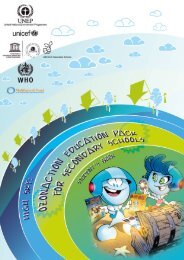Chapter 2. Progress towards the EFA goals - Unesco
Chapter 2. Progress towards the EFA goals - Unesco
Chapter 2. Progress towards the EFA goals - Unesco
You also want an ePaper? Increase the reach of your titles
YUMPU automatically turns print PDFs into web optimized ePapers that Google loves.
PROGRESS TOWARDS THE <strong>EFA</strong> GOALS<br />
Youth and adult literacy<br />
Figure <strong>2.</strong>34: Within countries, women’s literacy rates are influenced by socio-economic and geographic factors<br />
Female adult (18 and over) literacy rates, by area, ethnicity, income, language, religion or region, selected countries, latest available year<br />
100<br />
90<br />
80<br />
70<br />
Average<br />
Poorest<br />
Richest<br />
Urban<br />
Rural<br />
Addis Abeba<br />
region<br />
Kerala region<br />
Spanish language<br />
Ladino ethnicity<br />
Metropolitan/<br />
Central region<br />
Phnom Penh<br />
region<br />
Distrito Federal<br />
Spanish<br />
language only<br />
White ethnicity<br />
W. Cape region<br />
Black ethnicity<br />
Capital region<br />
Christian<br />
Ucayali region<br />
Castellano ethnicity<br />
Quechua ethnicity<br />
Female literacy rates (%)<br />
60<br />
50<br />
40<br />
Ouagadougou<br />
region<br />
Indian ethnicity<br />
North-Occidental<br />
region<br />
Oaxaca region<br />
Limpopo region<br />
ARMM*<br />
Muslim<br />
Cusco region<br />
30<br />
Rajasthan region<br />
O<strong>the</strong>r language<br />
Mondol Kiri/<br />
Rattanak Kiri region<br />
20<br />
Sénoufo ethnicity<br />
10<br />
0<br />
East region<br />
Fulfulde/<br />
Peul ethnicity<br />
Somali region<br />
Indigenous<br />
language only<br />
Burkina Faso Ethiopia India Guatemala Cambodia Mexico South Africa Philippines Peru<br />
Notes: Data for Burkina Faso (2003), Cambodia (2005), Ethiopia (2005), Guatemala (1999), India (2005) and Peru (2004) are from Demographic and Health Surveys.<br />
Data for Mexico (2005), <strong>the</strong> Philippines (2000) and South Africa (2001) are from population censuses. Countries are sorted by average female literacy rate.<br />
* Autonomous Region in Muslim Mindanao.<br />
Source: UNESCO-DME (2009).<br />
people. Bangladesh will have 16 million more illiterates<br />
than it would if <strong>the</strong> 2015 <strong>goals</strong> were achieved. 33<br />
Among <strong>the</strong> sub-Saharan African countries,<br />
Mozambique will face a deficit of <strong>2.</strong>6 million people,<br />
based on a target set using 1997 data (UIS, 2009d).<br />
Changing <strong>the</strong> trend —<br />
making <strong>the</strong> literacy decade count<br />
The disappointing progress <strong>towards</strong> <strong>the</strong> literacy goal<br />
set at Dakar reflects a collective failure of political<br />
commitment. While <strong>the</strong>re are many exceptions,<br />
governments and aid donors collectively have failed<br />
to attach sufficient weight to <strong>the</strong> eradication of<br />
illiteracy. There are encouraging signs, however,<br />
that this could be starting to change.<br />
Some are apparent at <strong>the</strong> international level. In 2003,<br />
<strong>the</strong> United Nations launched a literacy decade, with<br />
33. The Bangladesh and India targets are set using 2001 literacy data<br />
from <strong>the</strong> UIS database.<br />
Figure <strong>2.</strong>35: At <strong>the</strong> present rate, regions fur<strong>the</strong>st behind<br />
will miss <strong>the</strong> literacy target for 2015<br />
Adult (15 and over) illiteracy rates, by region: 2007, projected by 2015<br />
and required by 2015 to achieve <strong>the</strong> goal<br />
East Asia/Pacific<br />
Latin America/Caribbean<br />
Arab States<br />
Sub-Saharan Africa<br />
South/West Asia<br />
0 10 20 30 40<br />
Adult illiteracy rates (%)<br />
2007<br />
Projected 2015<br />
Goal by 2015<br />
Notes: The goal of achieving a 50% improvement in levels of adult literacy is measured<br />
by looking at <strong>the</strong> 1999 illiteracy rate, reflecting <strong>the</strong> original formulation of <strong>the</strong> goal as<br />
expressed in Jomtien in 1991. The adult illiteracy rate is computed by deducting <strong>the</strong><br />
adult literacy rate from 100. Regions are sorted by illiteracy rate goal by 2015.<br />
Sources: Annex, Statistical Table 2; UIS (2009b).<br />
101
















